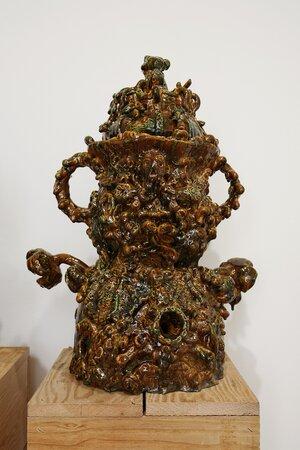Frye Favorites is a series in which members of the Frye’s staff and community share their perspectives on memorable exhibitions and works from the Museum’s collection.
This post features David Strand, Associate Curator, who will conclude his nine-year tenure at the Frye in June 2021. Beginning as a volunteer Gallery Guide in 2012, David held a range of roles in the exhibitions and curatorial departments throughout his time at the Museum. His recent curatorial projects include organizing Cherdonna Shinatra: DITCH (2019), Anastacia-Reneé: (Don’t Be Absurd) Alice in Parts (2021) and Boren Banner Series: Russna Kaur, on view through October 17, 2021.
“The first exhibition that I ever led tours of as a Gallery Guide was Mw [Moment Magnitude], back in 2012. I was a sophomore at Seattle University at that time, and I really wasn't that familiar with the Frye back then. Even though I was born and raised in Seattle, it wasn't a museum I grew up visiting.
![Installation view of Mw [Moment Magnitude], Frye Art Museum, October 13, 2012 – January 20, 2013](/sites/default/files/images/full-width/image-asset.jpeg)
Installation view of Mw [Moment Magnitude], Frye Art Museum, October 13, 2012 – January 20, 2013

Perfume Genius performing at the Frye Art Museum, October 27, 2012
But the Moment Magnitude show really affected me—it included all of these different artists, across so many disciplines, and it was very Seattle-centric. It was a pretty dynamic introduction and immersion into the contemporary art scene here. I really appreciated its inclusion of artists you wouldn’t necessarily expect to encounter in a museum setting, like musician Perfume Genius, whose music videos were part of the exhibition. He also performed in the galleries, which was the first time I saw Perfume Genius in concert. Now, I’ve seen him every time he's toured since then.
I also remember being really struck by Jeffry Mitchell's work in that exhibition, which included a large ceramic piece called Not Waving, but Drowning (2012), which is now in the Frye’s collection. I was drawn to the piece because it's so messy, organic, and layered in meanings and possible interpretations. There's something kind of abject to it—it’s slick and shiny like an elaborately adorned mud pie or something dredged from a sewer, but there's also a lot of beauty in it. It evokes many things all at the same time, being embellished with flowers, skulls, chains, and orifices.
Jeffry Mitchell. Not Waving, but Drowning (detail), 2012. Glazed earthenware on artist-made wood pedestal. 42 1/2 x 15 x 33 in. Purchased with funds provided by The New Foundation Seattle, 2013.009. Photo: Mark Woods

Jeffry Mitchell. Not Waving, but Drowning (detail), 2012. Glazed earthenware on artist-made wood pedestal. 42 1/2 x 15 x 33 in. Purchased with funds provided by The New Foundation Seattle, 2013.009. Photo: Mark Woods
Before it was exhibited at the Frye, it was part of a show at Ambach & Rice Gallery in Los Angeles called Shamrock Edelweiss Seaweed, which, aside from being an incredibly satisfying title to say out loud, also touches on some of the different aspects of Jeffry's identity. And, Jeffry's identity—as a white gay man, raised Irish Catholic, who's lived a lot of their life in the Pacific Northwest—is one that aligns quite a bit with my own identity. I have found kinship and recognition through his works, and I connect with a lot of the themes that he digs into. I love the unabashed but still coded queerness that's in his work—where sometimes it's subtle from a distance, but then quickly becomes anything but subtle up close. I feel like Jeffry has kind of upended his Irish Catholic upbringing, which can be really rigid and likes to keep things behind closed doors. His works don’t play by those rules at all. Instead, they’re unfettered, enthusiastic, and heartfelt.
So, while the piece itself holds meaning for me, it also holds additional resonance from being part of that exhibition, which was really foundational in sparking my interest in the Frye and in museums. It helped cultivate my desire to become a curator and helped demonstrate that foregrounding overtly queer work in museums was possible, so it became part of a moment that has driven me forward over the years.
When I joined the staff of the Frye several years later upon graduating from university, the first show that I project-managed was Genius / 21 Century / Seattle (2015-16) which also included Jeffry’s work. At this point, I had met Jeffry a number of times, and was enamored, like so many who have come in contact with him, by his incredible energy that just felt really encouraging and supportive. Jeffry exhibited what I grew to love most about the Seattle art scene—the way it felt like it had a kind of generosity rather than gatekeeping.
The other aspect of Jeffry’s work that I love is the way he layers so many references within a piece—there’s just so much that gets embedded—each one feels like a whole meal. Not Waving, but Drowning references a poem by Stevie Smith of the same title (1957). I think that that poem is a really powerful one. So much of Jeffry's work has this sense of play and whimsy and kitsch and queerness. I think this work has many of those elements, but it's not leading with them in quite the same fashion as, say, some other works where their palettes are brighter pastels and they’re softer and feel maybe more comfortable right away. I think that Not Waving, but Drowning really feels more unsettling at first glance.
Smith’s poem is about this figure who is drowning, but from the shore, people think it's just someone waving. She has talked about that poem as being about how many of us put on an air of being okay—of having it all together—so that we appear to be waving, when actually on the inside we are drowning or feeling lost in the world. That's an experience I definitely identify with both personally and professionally. I really appreciate how vulnerable Jeffry is in his work because he does so in such a genuine manner; he's often trying to negotiate and face his fears through his art making, which I think is really powerful.
It’s also what makes this piece inspiring to me as I leave the Frye. I’m remembering some of the core reasons I was drawn to the Museum in the first place. And, I’m also thinking about how I can negotiate my own fears around finding out what's next, how to keep a sense of play and whimsy but still acknowledge the really heavy aspects—and maybe I can let more of myself come to the surface in a more honest way from here on out so I’m not waving or drowning, just swimming.”
David Strand
Associate Curator
(as told to Erin Langner)